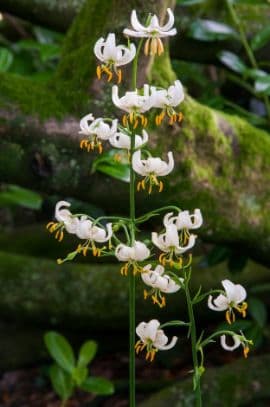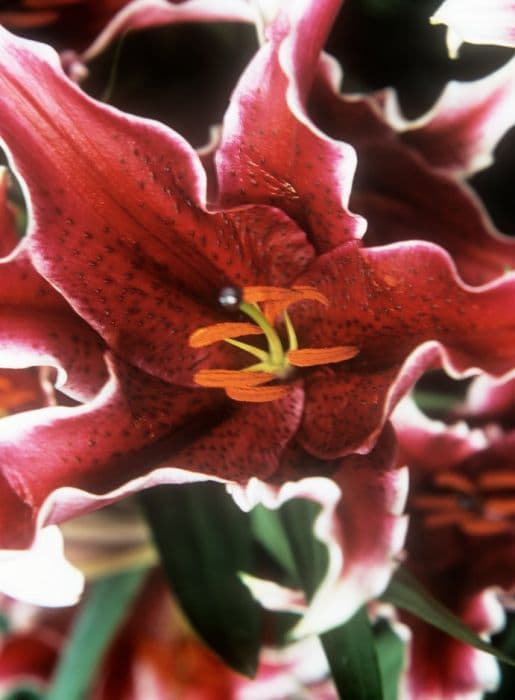Crown imperial 'William Rex' Fritillaria imperialis 'William Rex'

ABOUT
A bulbous perennial, to 90cm tall, with a dark-coloured, upright, sturdy stem bearing whorls of green lance-shaped leaves. In spring, terminal umbels of nodding, bronze-red and orange, bell-shaped flowers are borne and topped by leaf-like bracts
About this plant
 Names
NamesFamily
Liliaceae
Synonyms
Crown Imperial, Imperial Fritillary, Kaiser's Crown
Common names
Fritillaria imperiallis 'William Rex'
 Characteristics
CharacteristicsLife cycle
Perennials
Foliage type
Deciduous
Color of leaves
Green
Flower color
Orange
Height
3 feet (91 cm)
Spread
1 foot (30 cm)
Plant type
Bulb
Hardiness zones
5
Native area
Middle East
Benefits
 General Benefits
General Benefits- Ornamental value: The Fritillaria imperialis 'William Rex', commonly known as Crown Imperial, boasts striking blooms that add a dramatic touch to gardens and landscape designs.
- Attracts pollinators: The vivid flowers attract bees and other pollinating insects, which are vital for the health of many gardens and ecosystems.
- Deters rodents and other pests: The Crown Imperial has a strong scent that naturally repels rodents, deer, and other garden pests without the use of chemical deterrents.
- Spring interest: Blooming in early to mid-spring, it provides a splash of color after the winter months, bridging the gap until summer flowering plants begin to bloom.
- Height variation: With a height of up to 3 feet, the plant adds vertical interest to garden beds, borders, and containers.
- Low maintenance: Once established, Crown Imperial plants are relatively low maintenance, requiring minimal care beyond occasional watering and feeding.
- Drought tolerance: They are quite drought tolerant, making them suitable for xeriscaping and gardens in drier climates.
- Naturalizing: Over time, Fritillaria imperialis can naturalize and spread, creating larger displays of its distinctive blooms year after year.
 Medical Properties
Medical PropertiesThis plant is not used for medical purposes.
 Air-purifying Qualities
Air-purifying QualitiesThis plant is not specifically known for air purifying qualities.
 Other Uses
Other Uses- Crown Imperial bulbs can be used as a pest repellent in gardens since their strong scent is believed to deter moles, voles, and rodents.
- The extract from the plant has been utilized as a natural source for dyeing textiles, imparting a yellowish or orange hue to fabrics.
- In the past, crushed bulbs of Crown Imperial were applied to glass and metals as a rustic glue or adhesive for its sticky properties.
- Gardeners sometimes plant Crown Imperial as a natural marker for the end of the bulb planting season due to its late flowering time.
- The towering structure of the Crown Imperial can be used in landscape design to create vertical accents in flower arrangements and garden beds.
- During the Victorian era, Crown Imperial extracts were used in perfumery, although its strong musky odor made it a less common choice.
- Crown Imperial's tall and impressive flower stalks can be hollowed out and creatively used in crafts, such as natural vases for smaller flower arrangements.
- The plant's dried seed pods can be employed in floral art, providing an exotic touch to dried flower compositions and wreaths.
- Crown Imperial can be integrated into educational activities, teaching children about bulb planting and growth cycles in school gardens.
- In certain cultures, Crown Imperial is planted as a symbol of power and majesty in formal garden designs reflecting royal or high-status themes.
Interesting Facts
 Feng Shui
Feng ShuiThe Crown Imperial is not used in Feng Shui practice.
 Zodiac Sign Compitability
Zodiac Sign CompitabilityThe Crown Imperial is not used in astrology practice.
 Plant Symbolism
Plant Symbolism- Majesty: The common name "Crown Imperial" reflects its stately presence and majestic appearance, which often symbolizes power and prominence.
- Authority: With its crown-like arrangement of flowers atop a tall stem, the plant suggests regal authority and can represent leadership or superiority.
- Perseverance: The Crown Imperial blooms in early spring, often braving chilly weather, thus symbolizing endurance and the ability to thrive in adversity.
- Pride: Its lofty stature and commanding appearance are reminiscent of pride, whether as a positive attribute of self-respect or a negative connotation of arrogance.
 Water
WaterThe Crown Imperial (Fritillaria imperialis 'William Rex') should be watered deeply to ensure the soil is moist but not waterlogged, typically about 1 inch of water per week. During the growing season, water the plant when the top inch of soil feels dry to the touch, which may result in watering approximately every 7-10 days, depending on weather conditions. It's important to reduce watering after the foliage begins to die back post-flowering and during the dormant period to prevent bulb rot. Provide the plant with around half a gallon of water for each watering session to ensure the soil is adequately moistened.
 Light
LightCrown Imperials prefer full sunlight to thrive and produce the best blooms, requiring at least 6 hours of direct sunlight daily. They can tolerate partial shade but may not flower as prolifically. Place the Crown Imperial where it will receive unfiltered sunlight throughout the day for optimal growth and flowering.
 Temperature
TemperatureCrown Imperials are best suited for cooler climates and can endure winter temperatures as low as 10°F but not below -10°F. Ideally, they prefer daytime temperatures between 50°F and 70°F. It is critical to protect them from extreme heat, as temperatures consistently above 80°F could be detrimental to their growth and health.
 Pruning
PruningPrune Crown Imperials by deadheading spent flowers shortly after they fade to conserve plant energy. Cut back the foliage only after it has turned yellow and begun to die down on its own, usually in late spring or early summer. Pruning is typically not required at other times unless removing damaged or diseased foliage.
 Cleaning
CleaningAs needed
 Soil
SoilCrown Imperial Fritillaria prefers well-draining, fertile soil with abundant organic matter. Aim for a soil pH between 6.0 and 7.0. A mix of loam, sand, and compost would serve as an ideal soil composition for this plant to ensure good drainage and nutrient availability.
 Repotting
RepottingCrown Imperial Fritillarias are generally repotted every few years or when they outgrow their current container. It's best to repot after the foliage has died back, in late summer or early fall, as this plant is a spring bloomer.
 Humidity & Misting
Humidity & MistingCrown Imperial Fritillaria is tolerant of a range of humidity levels but does not require high humidity. Average room humidity is usually sufficient for this plant when grown indoors.
 Suitable locations
Suitable locationsIndoor
Ensure bright light, cool temperatures, and well-draining soil.
Outdoor
Plant in full sun to part shade, well-draining soil, springtime.
Hardiness zone
5-9 USDA
 Life cycle
Life cycleCrown Imperial 'William Rex' begins its life as a bulb, which is typically planted in the fall to establish roots before the winter. In spring, the bulb sends up a stout stem, which bears lance-shaped, glossy leaves and a prominent, crown-like arrangement of bell-shaped flowers, ranging from red to yellow, blooming from late March to May. After flowering, the plant goes into a period of photosynthesis and energy storage, replenishing the bulb for the next season. As the temperatures warm up in late spring or early summer, the foliage dies back and the plant enters a dormancy phase during the hot summer months. In this resting state, the bulb survives underground until the following spring when the cycle begins anew with the emergence of new growth. With each annual cycle, the bulb can grow larger and may eventually produce offsets, or daughter bulbs, which can be separated and planted to propagate new plants.
 Propogation
PropogationPropogation time
Spring
Propogation: Fritillaria imperialis 'William Rex', commonly known as Crown Imperial, is typically propagated by bulb division. The best time to propagate this plant is in the autumn, after the foliage has died back and the plant is dormant. The large bulbs of the Crown Imperial can be carefully dug up and the offsets, which are smaller bulbs that grow attached to the mother bulb, can be separated. Each offset must have some roots attached to ensure successful growth. These offsets can then be planted immediately at a depth of approximately 6 inches (about 15 centimeters) in well-draining soil with the pointed end facing upwards. It is important to space them about 12 inches (30 centimeters) apart to give them enough room to grow. With proper care, these offsets will develop into mature flowering plants in a few years.




![Lily [Roselily Chelsea]](/_next/image?url=https%3A%2F%2Fplants-admin.emdemapps.com%2Fimages%2Fplants%2F%2Fimages%2F604b584f6f830.png&w=640&q=75)




